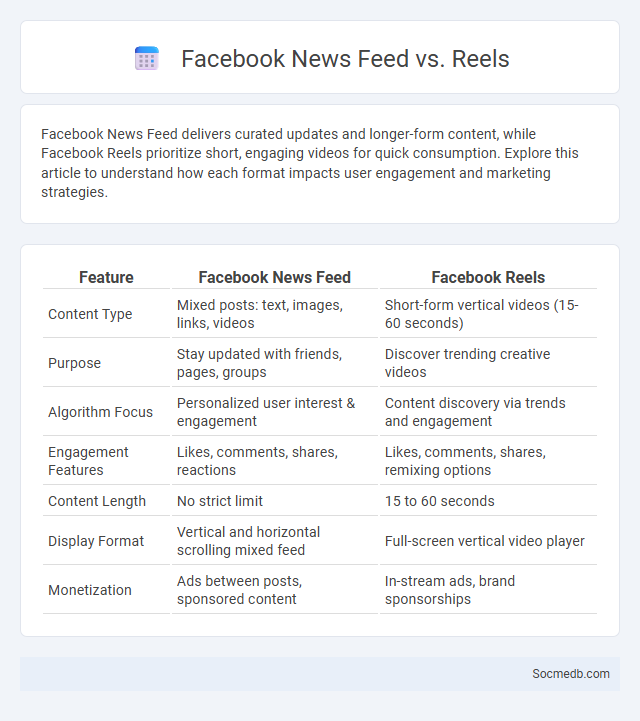
Photo illustration: Facebook News Feed vs Reels
Facebook News Feed delivers curated updates and longer-form content, while Facebook Reels prioritize short, engaging videos for quick consumption. Explore this article to understand how each format impacts user engagement and marketing strategies.
Table of Comparison
| Feature | Facebook News Feed | Facebook Reels |
|---|---|---|
| Content Type | Mixed posts: text, images, links, videos | Short-form vertical videos (15-60 seconds) |
| Purpose | Stay updated with friends, pages, groups | Discover trending creative videos |
| Algorithm Focus | Personalized user interest & engagement | Content discovery via trends and engagement |
| Engagement Features | Likes, comments, shares, reactions | Likes, comments, shares, remixing options |
| Content Length | No strict limit | 15 to 60 seconds |
| Display Format | Vertical and horizontal scrolling mixed feed | Full-screen vertical video player |
| Monetization | Ads between posts, sponsored content | In-stream ads, brand sponsorships |
Overview: Understanding Facebook News Feed, Reels, and Stories
Facebook's News Feed algorithm prioritizes personalized content by analyzing user interactions, engagement patterns, and preferences to deliver relevant posts consistently. Reels, designed to compete with TikTok, promote short-form video content that boosts user engagement through trends, music integration, and creative tools. Stories offer ephemeral, full-screen content that encourages authentic, real-time sharing, enhancing social connectivity and immediacy among users.
Core Features of Facebook News Feed
Facebook News Feed highlights personalized content delivery based on user interactions, preferences, and social connections to maximize engagement and relevance. Core features include an algorithm-driven timeline displaying posts from friends, pages, and groups, real-time updates, and interactive elements such as likes, comments, and shares. The platform incorporates sponsored content and trending topics to blend organic and paid posts effectively, enhancing visibility and user experience.
What Makes Facebook Reels Unique?
Facebook Reels stands out due to its seamless integration within the Facebook ecosystem, allowing users to access content without leaving the main app. The platform leverages Facebook's extensive user data to provide personalized video recommendations and relevant trends. Enhanced social interaction features, such as easy sharing, commenting, and seamless cross-posting to Instagram Reels, contribute to its unique appeal among short-form video platforms.
Stories on Facebook: Highlights and Uses
Facebook Stories provide a dynamic way to share fleeting moments through photos, videos, and text that disappear after 24 hours, enhancing real-time engagement. Businesses leverage Stories to highlight promotions, behind-the-scenes content, and interactive polls, boosting brand visibility and customer interaction. The format's vertical orientation and immersive features, such as stickers and filters, increase user attention and drive higher conversion rates compared to traditional posts.
Content Discovery: How Each Format Reaches Users
Social media platforms use distinct content discovery algorithms tailored to each format such as reels, stories, posts, and live videos to maximize user engagement and reach. Reels benefit from short, engaging clips pushed through For You pages, while stories prioritize timely, ephemeral content shown prominently to close connections. Understanding how your content format leverages platform-specific discovery methods helps you optimize visibility and connect with your target audience effectively.
Engagement: Comparing User Interaction Across Formats
User engagement varies significantly across different social media formats, with video content generating up to 120% more interactions than images or text posts on platforms like Instagram and Facebook. Interactive features such as polls, stories, and live streams boost participation rates by encouraging real-time feedback and deeper connections. To maximize your social media impact, focus on formats that foster active user involvement, enhancing both reach and brand loyalty.
Algorithm Differences: What Drives Visibility
Social media platforms employ distinct algorithms to determine content visibility, with Facebook prioritizing user engagement and relevance through its EdgeRank system, while Instagram's algorithm focuses on user interests, recency, and relationship strength. Twitter's timeline algorithm emphasizes recency and popularity, integrating machine learning to tailor content based on user interactions. YouTube relies heavily on watch time, viewer retention, and personalization cues to surface videos, demonstrating how algorithmic priorities shape content reach across networks.
Content Creation: Best Practices for News Feed, Reels, and Stories
Creating engaging content for your social media feeds involves tailoring posts to fit the unique formats of News Feed, Reels, and Stories, maximizing reach and interaction. Prioritize high-quality visuals and concise messaging for News Feed updates, leverage dynamic, short-form videos with trending audio for Reels, and use interactive features like polls and stickers in Stories to boost viewer engagement. You can enhance your brand presence by consistently analyzing platform-specific metrics and adjusting content strategies to meet audience preferences.
Monetization Opportunities for Creators and Brands
Social media platforms offer diverse monetization opportunities for creators and brands, including sponsored content, affiliate marketing, and direct sales through integrated shops. By leveraging analytics and audience insights, you can optimize content strategies to maximize engagement and revenue streams. Creative collaborations and exclusive memberships further enhance earning potential and brand visibility in competitive digital markets.
Choosing the Right Format: Strategy for Maximum Impact
Choosing the right social media format involves analyzing audience preferences, platform algorithms, and content goals to maximize engagement and reach. Formats such as short videos, carousel posts, and live streams cater to different consumption habits and boost visibility on platforms like Instagram, TikTok, and Facebook. Tailoring content format to platform-specific strengths enhances brand awareness and drives higher interaction rates.
 socmedb.com
socmedb.com